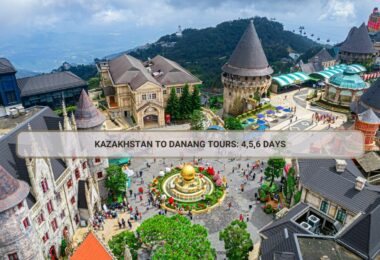The Ho Chi Minh Museum in Da Nang is an important cultural as well as historical landmark that is frequented by many people who are keen to know more about the historic past of the country and also the life of President Ho Chi Minh. Situated in the bustling city of Da Nang, the museum tells the complete story of the life of Ho Chi Minh and what he did to go down in history in Vietnam. For tourists as well as history lovers, the museum is a complete experience that is educative and motivational at the same time. This article discusses the various features of the museum, the importance that it holds, and the things that visitors can expect to watch.
Historical Background of Ho Chi Minh Museum in Da Nang

Museum history
The Ho Chi Minh Museum in Da Nang was founded in 1976 and was opened for official public access on the 19th of May the next year, a day set aside to remember and celebrate the life and works of President Ho Chi Minh. The museum is an integral component of the Fifth Military Division Museum, which is also popularly known as the Zone 5 Military Museum. The collaboration here signifies the significant role of the museum in the conservation of the historical legacy as well as the military heritage of the region.
The Museum was erected as an expression of the deepest respect and admiration the people as well as the soldiers of the Fifth Military Division felt for Ho Chi Minh. Through the construction of this place dedicated to his memory, they wanted to pass on to the new generations his teachings, so that they would be able to know and to be moved by what this outstanding man managed in favor of the independence as well as the unification of Vietnam. The construction of the museum was also a way of paying homage to the martyrs, those who gave their lives in the battles for independence by the side of Ho Chi Minh.
Architectural Design and Arrangements of Ho Chi Minh Museum in Da Nang

Ho Chi Minh Museum in Da Nang
The Ho Chi Minh Museum in Da Nang is spread over a large area of 9 hectares and is divided into two separate sections: the outdoor and indoor displays. The architectural layout of the museum is not only practical but symbolic in a way that speaks of the plainness and unpretentiousness for which Ho Chi Minh’s living is commemorated.
The stilt house forms the central feature of this museum, and this is the exact replica of the house in which Ho Chi Minh lived during his days in Hanoi. The museum premises also encompass a well-manicured garden and a tranquil fish pond surrounding the building, which imparts a quiet and contemplative atmosphere. The garden as well as the fish pond has been laid out as part of the landscape features in a way as to more than amply bring out the quietness of the surroundings so loved by Ho Chi Minh himself.
There are many personal effects and articles in the stilt house that tell one of the life and work of Ho Chi Minh on an everyday basis. The house per se tells volumes about his humility and sincerity towards the people of Vietnam.
Outdoor Display

Outdoor display area
The complex located around the Ho Chi Minh Museum in Da Nang represents an exposition of large-sized military equipment, such as tanks, helicopters, and anti-aircraft guns. All the displays not only amaze by their size but do that in matters of historical significance. Every item of the equipment shows the stories of battles and victories of the military forces of Vietnam, fighting for their independence. Among the more outstanding are displays of armaments captured from French and American forces, mute testimony to the war that was carried on this soil as well as the resilience of the Vietnamese. The outdoor displays also include different types of military vehicles and cannons, complete with informative narration on their operation and efficacy in battle during the war.
Inside Exhibits and Galleries

inside the exhibition
The Ho Chi Minh Museum in Da Nang provides profound and thoughtful insight into the life and works of President Ho Chi Minh in its painstakingly made indoor exhibits. The museum comprises four major showrooms with exhibitions of the life and works of Ho Chi Minh, imparting a holistic view to the visitors regarding his contributions towards the independence struggle of Vietnam and his perpetual legacy to the country.
- Supposed to be the first showroom is a showroom that reflects the early life of Ho Chi Minh, depicting his growth from a young patriot to the leader of the revolution in Vietnam. There are rare photographs, personal letters, and his personal belongings of his youth years that display his undivided devotion to fighting for independence for the country.
- The next showroom shows the works of Ho Chi Minh in the founding and leading the Vietnamese Communist Party. At this location, there are some documents and memorabilia that have been related to some significant events that had shown the formation of the party and the fight against the colonial powers of the party.
- The third showroom showcases the leadership of Ho Chi Minh in the wars of revolution, and the weapons and military dress, as well as the strategic maps used in significant battles, can be seen in this third part. It is this section that offers a sharp look at the military strategy that Ho Chi Minh and his comrades unveiled in the procurement of freedom.
- The fourth showroom has been dedicated in the memory of Ho Chi Minh himself, and some of his personal effects have thus been placed here. The room has his collection of awards and decorations from all over the world. Some of his personal belongings, like his reading glasses, walking stick, and traditional clothing from Vietnam, have also been put on display, and thus, people get a peep into the personal life of the man.
Apart from the four main showcases, the Ho Chi Minh Museum in Da Nang also has eight other chambers through which the history of the Fifth Division army can be seen. These chambers are stocked with thousands of photographs and objects that bear upon the description of the heroic soldiers who took part in the Vietnamese resistance wars against the French and American forces.
Each of the rooms is dedicated to a specific chapter of the history of the Fifth Division, starting from the early years of the resistance and finishing with the final victory. The exhibits include the weapons of the soldiers, military equipment, and their personal things, and graphically tell about the heavy conditions of their service and the gigantic sacrifices they had to bring. Some of the interesting highlights of such rooms include a display of rare items and difficult-to-source photographs that highlight the ingenuity as well as the innovative nature of the Vietnamese during the period of the wars.
Unique Artifacts and Narratives of Ho Chi Minh Museum in Da Nang
The Da Nang Ho Chi Minh Museum has on display two very special objects of great courage and creativity. One of them is the 2-layer pair of shoes of Mr. Ho Le Phuong, a resident of Hoa Cuong ward. The pair of shoes, otherwise resembling a normal pair of shoes, had a second layer built inside, through which Mr. Phuong and his wife used to carry documents secretly to their son who was working as a shoemaker in the city during the war. His ingenuity in building these shoes, using a hidden compartment to make sure they are not detected by American soldiers, says a lot about his innovativeness.
Another incredible artifact is the slippers of Ms. Phan Thi Mua, who despised the American Army from the bottom of her heart because they killed her mother. Ms. Mua, when she was only 17, performed the dangerous duty of demolishing the enemy’s petroleum storage on Trung Nu Vuong Street. She was carrying gunpowder under her sandals daily clandestinely until she collected a good amount of that in order to make a massive explosion in August of 1972. Not only did the heroic act of Ms. Mua act as a setback to the American forces but also inspired the local people.
These individual stories and artifacts contribute to the museum’s larger narrative by emphasizing the small acts of heroism that contributed to the shaping of Vietnam’s independence struggle. They constitute a human dimension to the larger events of the past because they put a face on the displays of the museum and make them more personal as well as more meaningful.
Visitation Information

Artifacts in the museum
For the people who are planning to pay a visit to the Ho Chi Minh Museum in Da Nang, it is situated at 01 Duy Tan Street, Hai Chau District, Da Nang. The museum can be visited by visitors between the hours of 8:00 AM to 11:00 AM and 2:00 PM to 5:00 PM on the working days from Monday to Friday. Entry tickets are free of charge for visitors from Vietnam, while foreign tourists are supposed to pay a meager amount of 20,000 VND per head.
It is recommended that for maximum benefit, you should visit the place early in the cooler hours of the morning so you can go through the outdoor exhibits more comfortably. Not only that, you can also avail the local guide services, because they will provide you with more informative perspectives and historical insight that one might not get to know very easily.
For those who are interested in Danang Tours, it is worth considering a visit to the Ho Chi Minh Museum in your travel itinerary. Some of the other nearby sites include the Da Nang Museum of Cham Sculpture, Dragon Bridge, and the Marble Mountains, all of which provide unique cultural and historical experiences.
Conclusion
All in all, the Ho Chi Minh Museum in Da Nang is a place that should be visited by anyone who wants to gain insight into the history of Vietnam and the life of one of its best sons. The extensive exhibits, unique artifacts, and moving individual stories all lead up to a seamless and mesmerizing whole that educates and inspires. As you plan your itinerary for your Da Nang visit, make sure you include ample time for this important cultural facility in your schedule so that you will have a deeper appreciation of the rich culture of Vietnam and the lasting impact of the great man, Ho Chi Minh.Don’t forget to regularly follow our Fanpage for more interesting information about traveling to Danang and to book Danang tours at the best prices.


































































